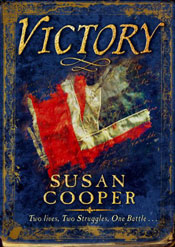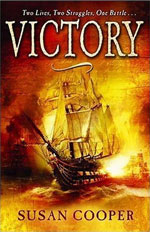



Two children cross an ocean, two hundred years apart. One is Sam Robbins, a powder monkey aboard H.M.S. Victory, the ship in which Lord Nelson will die a hero's death at the Battle of Trafalgar in 1805. The other is Molly Jennings, a present-day English girl transplanted from London to America, fighting a battle of her own against loss and loneliness.
This extraordinary time-shifting adventure tells the interwoven stories of Sam and Molly, linked by a mystery. Sam is a farm boy, kidnapped by the "press gang" to serve in the Royal Navy. At first terrified and seasick, he is transformed gradually into a sailor. In the rowdy, dangerous world of a warship enduring the Napoleonic Wars, he meets both cruelty and kindness, and survives a fearsome battle whose echoes reach through the years to involve Molly as well. Like him, she has lost her childhood, but will find her future with help, from a much unexpected source. Separate yet together, Sam and Molly struggle through fear and excitement to a final ordeal, which terrifyingly tests their courage. And the moving climax of the book shows two lives joined forever, by the touch of Nelson, one of the greatest sailors of all time.
![]()
Susan and I sit on the top deck of a river-boat, chugging gently downstream on the River Thames in London, England. The sun is strong, and the wind rushes past our ears making it difficult to hear. Unfortunately, the wind-rush is not sufficient to drown out the interminable narration from our young guide who gleefully tells us the history of this great river and the buildings that crowd along its banks. I should not be so harsh, there is nowhere like London and the River Thames and, for Susan and I, this journey allows us to re-acquaint ourselves with old friends: the great images and the unique atmosphere of London, a common and loved place in both our lives.
 And we are on an amazing journey. From our berth in
Westminster, in the shadow of the Palace of Westminster, with Big Ben looming
over us, we pass the London Eye, the Tate Modern, Shakespeare’s Globe, St Paul’s
Cathedral, the Tower of London and the gothic splendour of Tower Bridge. There
is still more to come as we head to Greenwich.
And we are on an amazing journey. From our berth in
Westminster, in the shadow of the Palace of Westminster, with Big Ben looming
over us, we pass the London Eye, the Tate Modern, Shakespeare’s Globe, St Paul’s
Cathedral, the Tower of London and the gothic splendour of Tower Bridge. There
is still more to come as we head to Greenwich.
We catch up, and talk about friends and family. Soon enough our talk turns to Susan’s latest book, undergoing final revision and one of the reasons for our trip. Then, the working title was Full Fathom Five in the UK, and Sea Change in America, now to be published on both sides of the Atlantic as Victory.
In Greenwich, we enjoy a pub lunch and a glass of Fuller’s beer and head for the National Maritime Museum, a great old Naval College on the banks of the River Thames. We wander around for a while, looking at this and that, of all things to do with the sea and Britain’s great Naval Heritage. But something unspoken pulls us deeper into the building until, at last, Susan and I stand in front of a gently lit display case.
Inside, vivid blue still, with shimmering gold, is Horatio Nelson’s uniform. The very uniform he was wearing when he died at the Battle of Trafalgar 200 years before. We say little. I comment with some surprise that he was only a small man, slight, with tiny feet – not at all the hero-image created for us by modern day action films.
Susan looks close and then stands back, she makes a few notes (on her Shakespeare notepad). I watch and move closer. We stand and look one last time before leaving.
“He's a hero,” Susan says quietly. “My hero.”